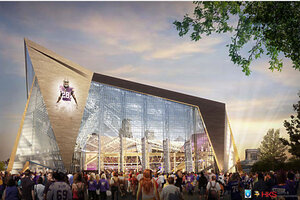Vikings stadium could send birds off to Valhalla, Audubon Society says
The Audubon Society has criticized the design for the Minnesota Vikings stadium under construction, saying the humongous glass windows could spell death for unsuspecting birds.

Rendering of new Minnesota multi-purpose stadium.
Image courtesy of HKS Sports and Entertainment Group/Minnesota Sports Facilities Authority/PRNewsFoto
With its 200,000-square-foot walls of glass, the planned Minnesota Vikings stadium may feel open and natural for spectators, but these nearly invisible walls could be a "death trap" for songbirds, says Audubon Minnesota.
To a flying bird, these giant, reflective windows will look like a continuation of the blue sky, puffy clouds, and green trees around the stadium. Until the sudden stop, that is.
To prevent these collisions, the Audubon Society has suggested a bird-safe glass that is less reflective. But that would cost an estimated $1.1 million extra.
The Authority said in a statement that they do not have the budget for the special glass, an assertion that Audubon finds dubious.
"We’re talking about a billion dollar stadium here, and the cost to save perhaps thousands of migratory birds – and make the Vikings a global leader in green stadium design – is about one-tenth of one percent of that," said Audubon Minnesota Executive Director Matthew Anderson in a news release.
Just last month, the MSFA approved a $1.3 million increase to the project budget in order to add 1,200 televisions to the original 800, and 6 escalators to the original 27.
Audubon also points out that the project is partly funded – to the tune of about $468 million – by Minnesota’s sale of bonds. "Hundreds of millions of dollars of public money is going to build this stadium, and we know the people of Minnesota do not want their money killing birds," said Mr. Anderson.
This project may provide no benefit to Minnesota's birds, but other state residents are profiting from it. According to a statement by the MSFA, Minnesotans have performed 92 percent of the work hours put into the project in the past six months.
"One of the design goals was to create a building that was more connected and integrated with the community than the Metrodome had been," said MSFA chairwoman Michele Kelm-Helgen in a news release. "The ability to see in and out of the stadium was what led us to the design that included the [translucent plastic] roof and operable doors on the downtown facing wall."
Set to open in 2016, the stadium was selected to be the site of Super Bowl LII, in 2018.
Although the MSFA will not use non-reflective glass, they have agreed to meet “lights out” guidelines set by Audubon. This means that when the stadium is empty, the lights will be turned off. Tall, lit buildings can be distracting and disorienting for birds, according to the Audubon Society.
About 988 million birds die each year after crashing into reflective windows across the country, according to Audubon estimates. Many migrating birds travel along the Mississippi River between seasons. The stadium, under a mile away from the river, will see traffic from fliers such as the Ovenbird, the Nashville Warbler, and the White-throated Sparrow.

